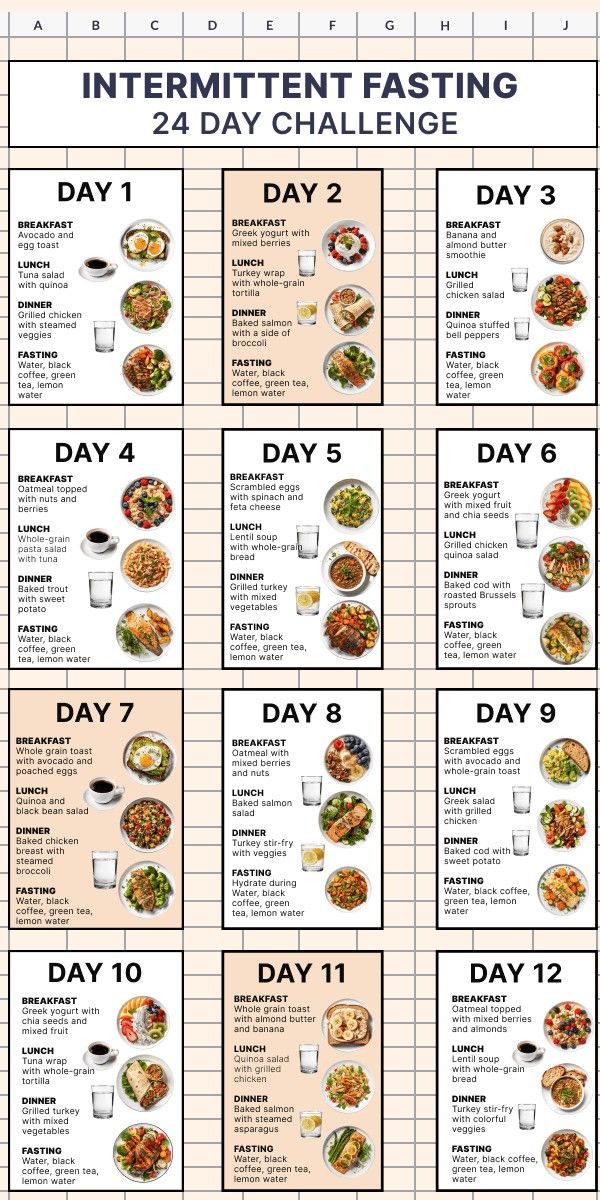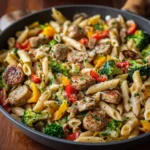Are you interested in jumpstarting your wellness journey and shedding a few extra pounds? Intermittent fasting has become one of the most popular approaches for weight management, improved energy levels, and general health optimization. This 24-day challenge provides a structured way to blend time-restricted eating with balanced, nutrient-dense meals. In this article, we’ll dive deep into the principles of intermittent fasting, discuss the benefits and potential drawbacks, and walk you through a carefully planned 24-day meal guide.
Disclaimer: The information in this article is intended for general informational purposes only. It should not be considered medical advice. Always consult a qualified healthcare professional before starting any new diet or exercise program.
Table of Contents
- What Is Intermittent Fasting?
- How Does Intermittent Fasting Work?
- Potential Benefits of Intermittent Fasting
- Possible Risks and Considerations
- Overview of the 24-Day Challenge
- Daily Meal Plans and Fasting Schedule
- Day 1
- Day 2
- Day 3
- Day 4
- Day 5
- Day 6
- Day 7
- Day 8
- Day 9
- Day 10
- Day 11
- Day 12
- Day 13
- Day 14
- Day 15
- Day 16
- Day 17
- Day 18
- Day 19
- Day 20
- Day 21
- Day 22
- Day 23
- Day 24
- Helpful Tips for Success
- Frequently Asked Questions (FAQ)
- Final Thoughts and Next Steps
1. What Is Intermittent Fasting?
Intermittent fasting (IF) is an eating pattern that cycles between periods of eating and fasting. Rather than focusing on what you eat (though a balanced diet is certainly important), intermittent fasting focuses on when you eat. Typical approaches include the 16/8 method, 5:2 method, and alternate-day fasting. However, all variations share a common aim: to give your body a break from constant digestion and allow it to tap into fat stores as an energy source.
- 16/8 Method: Fast for 16 hours and limit your eating window to 8 hours each day.
- 5:2 Method: Eat normally 5 days a week, then restrict calories significantly (around 500–600 calories) on 2 non-consecutive days.
- Alternate-Day Fasting: Fast every other day, or keep your calorie intake very low (around 500 calories) on fasting days.
For beginners, the 16/8 method tends to be the most approachable. You can choose an 8-hour eating window that suits your lifestyle (for instance, 12:00 p.m.–8:00 p.m.), then fast the rest of the time.
2. How Does Intermittent Fasting Work?
During fasting periods, your body uses stored glycogen (carbohydrates) for energy. After a certain number of hours without food, glycogen levels become depleted, and your body begins to break down stored fat for fuel. This metabolic shift is one of the main reasons people experience weight loss benefits with intermittent fasting.
Moreover, while fasting, levels of certain hormones—including insulin—can fluctuate, sometimes leading to improved insulin sensitivity. Intermittent fasting may also help optimize levels of human growth hormone (HGH) and other hormones that can positively impact body composition and overall health.
3. Potential Benefits of Intermittent Fasting
- Weight Management
Many people turn to intermittent fasting as a tool to help control calorie intake and support weight loss. - Improved Metabolic Health
Studies suggest that IF can enhance insulin sensitivity and potentially lower the risk of type 2 diabetes. - Cellular Repair
Fasting may boost autophagy, a cellular “cleanup” process that removes damaged cells and helps the body regenerate healthier tissue. - Heart Health
By encouraging a more balanced diet and potentially lowering overall caloric intake, intermittent fasting could support healthy cholesterol and triglyceride levels. - Enhanced Mental Clarity
Some individuals report improved mental clarity and focus during fasting, possibly due to a steady energy supply from fat metabolism. - Flexibility
Intermittent fasting can be easier for some people to follow compared to traditional calorie-counting diets because there’s no need to track every single meal if you can stick to a consistent fasting schedule.
4. Possible Risks and Considerations
While intermittent fasting can be beneficial for many, it’s not suitable for everyone. Potential concerns include:
- Nutrient Deficiency: If your food choices are poor during eating windows, you may not get enough essential vitamins and minerals.
- Eating Disorders: Individuals with a history of disordered eating should be cautious, as fasting windows can trigger harmful behaviors.
- Blood Sugar Issues: People with diabetes or hypoglycemia must monitor blood sugar levels carefully and seek professional guidance.
- Medical Conditions or Pregnancy: Always consult a healthcare provider if you have existing health issues or are pregnant or breastfeeding.
5. Overview of the 24-Day Challenge
Our 24-Day Intermittent Fasting Challenge takes the typical 16/8 approach, with a structured meal plan to ensure balanced nutrient intake. You’ll fast for 16 hours daily, focusing your meals within an 8-hour window. During the fasting period, you can consume:
- Water (plain or infused with lemon)
- Black coffee (no sugar, no creamer)
- Unsweetened green tea or herbal teas
Each day features three main meals—Breakfast, Lunch, and Dinner—within the 8-hour eating window. The meals prioritize whole grains, lean proteins, healthy fats, and a variety of fruits and vegetables.
6. Daily Meal Plans and Fasting Schedule
Below is a detailed overview of each day’s meals. While the plan suggests a specific Breakfast-Lunch-Dinner routine, feel free to adjust meal timing to fit your schedule. For instance, you could shift everything later if you prefer a brunch-lunch-dinner approach.
Day 1
- Breakfast: Avocado and egg toast
- Lunch: Tuna salad with quinoa
- Dinner: Grilled chicken with steamed veggies
- Fasting Beverages: Water, black coffee, green tea, lemon water
Day 2
- Breakfast: Greek yogurt with mixed berries
- Lunch: Turkey wrap with a whole-grain tortilla
- Dinner: Baked salmon with a side of broccoli
- Fasting Beverages: Water, black coffee, green tea, lemon water
Day 3
- Breakfast: Banana and almond butter smoothie
- Lunch: Grilled chicken salad
- Dinner: Quinoa stuffed bell peppers
- Fasting Beverages: Water, black coffee, green tea, lemon water
Day 4
- Breakfast: Oatmeal topped with nuts and berries
- Lunch: Whole-grain pasta salad with tuna
- Dinner: Baked trout with sweet potato
- Fasting Beverages: Water, black coffee, green tea, lemon water
Day 5
- Breakfast: Scrambled eggs with spinach and feta cheese
- Lunch: Lentil soup with whole-grain bread
- Dinner: Grilled turkey with mixed vegetables
- Fasting Beverages: Water, black coffee, green tea, lemon water
Day 6
- Breakfast: Greek yogurt with mixed fruit and chia seeds
- Lunch: Grilled chicken quinoa salad
- Dinner: Baked cod with roasted Brussels sprouts
- Fasting Beverages: Water, black coffee, green tea, lemon water
Day 7
- Breakfast: Whole-grain toast with avocado and poached eggs
- Lunch: Quinoa and black bean salad
- Dinner: Baked chicken breast with steamed broccoli
- Fasting Beverages: Water, black coffee, green tea, lemon water
Day 8
- Breakfast: Oatmeal with mixed berries and nuts
- Lunch: Baked salmon salad
- Dinner: Turkey stir-fry with veggies
- Fasting Beverages: Water, black coffee, green tea, lemon water
Day 9
- Breakfast: Scrambled eggs with avocado and whole-grain toast
- Lunch: Greek salad with grilled chicken
- Dinner: Baked cod with sweet potato
- Fasting Beverages: Water, black coffee, green tea, lemon water
Day 10
- Breakfast: Greek yogurt with mixed fruits and granola
- Lunch: Turkey wrap with whole-grain tortilla
- Dinner: Baked turkey with roasted vegetables
- Fasting Beverages: Water, black coffee, green tea, lemon water
Day 11
- Breakfast: Whole-grain toast with almond butter and banana slices
- Lunch: Chicken salad with whole-grain croutons
- Dinner: Baked salmon and asparagus
- Fasting Beverages: Water, black coffee, green tea, lemon water
Day 12
- Breakfast: Oatmeal topped with mixed berries
- Lunch: Lentil soup with whole-grain bread
- Dinner: Turkey stir-fry with colorful veggies
- Fasting Beverages: Water, black coffee, green tea, lemon water
Day 13
- Breakfast: Smoothie with spinach, mango, and almond milk
- Lunch: Brown rice sushi rolls with cucumber, carrot, or tuna
- Dinner: Grilled chicken with steamed zucchini
- Fasting Beverages: Water, black coffee, green tea, lemon water
Day 14
- Breakfast: Scrambled egg whites with tomatoes and spinach
- Lunch: Quinoa salad with chickpeas, tomatoes, and olive oil
- Dinner: Baked white fish with roasted cauliflower
- Fasting Beverages: Water, black coffee, green tea, lemon water
Day 15
- Breakfast: Greek yogurt parfait with berries, honey, and flax seeds
- Lunch: Veggie wrap with whole-grain tortilla (spinach, bell peppers, hummus)
- Dinner: Grilled turkey burger (no bun) with a side salad
- Fasting Beverages: Water, black coffee, green tea, lemon water
Day 16
- Breakfast: Protein smoothie (whey or plant-based protein, banana, almond milk)
- Lunch: Salmon salad with leafy greens and a light vinaigrette
- Dinner: Baked chicken thighs with sweet potato wedges
- Fasting Beverages: Water, black coffee, green tea, lemon water
Day 17
- Breakfast: Whole-grain toast with cottage cheese and sliced tomatoes
- Lunch: Lentil and vegetable stew
- Dinner: Grilled shrimp with brown rice and sautéed spinach
- Fasting Beverages: Water, black coffee, green tea, lemon water
Day 18
- Breakfast: Oatmeal with apples, cinnamon, and walnuts
- Lunch: Tuna-stuffed bell peppers with a side salad
- Dinner: Turkey meatballs with zucchini noodles
- Fasting Beverages: Water, black coffee, green tea, lemon water
Day 19
- Breakfast: Poached egg over whole-grain toast, topped with avocado slices
- Lunch: Baked tofu (or chicken) with kale salad
- Dinner: Grilled steak (lean cut) with roasted vegetables
- Fasting Beverages: Water, black coffee, green tea, lemon water
Day 20
- Breakfast: Greek yogurt bowl with berries, chia seeds, and a drizzle of honey
- Lunch: Whole-grain pita stuffed with grilled chicken and veggies
- Dinner: Salmon fillet with quinoa and steamed broccoli
- Fasting Beverages: Water, black coffee, green tea, lemon water
Day 21
- Breakfast: Veggie omelet (spinach, mushrooms, onions)
- Lunch: Chickpea salad with cucumber, tomatoes, and feta (optional)
- Dinner: Grilled turkey breast with brown rice and asparagus
- Fasting Beverages: Water, black coffee, green tea, lemon water
Day 22
- Breakfast: Oatmeal topped with bananas, peanut butter, and chia seeds
- Lunch: Whole-grain pasta with spinach and grilled shrimp
- Dinner: Baked cod with mixed roasted vegetables (carrots, Brussels sprouts)
- Fasting Beverages: Water, black coffee, green tea, lemon water
Day 23
- Breakfast: Scrambled eggs with bell peppers and onions
- Lunch: Lentil soup with whole-grain bread (optional side salad)
- Dinner: Grilled turkey with sautéed zucchini and squash
- Fasting Beverages: Water, black coffee, green tea, lemon water
Day 24
- Breakfast: Banana and strawberry smoothie with Greek yogurt
- Lunch: Chicken salad with whole-grain croutons and olive oil dressing
- Dinner: Baked salmon with cauliflower rice and steamed broccoli
- Fasting Beverages: Water, black coffee, green tea, lemon water
7. Helpful Tips for Success
- Stay Hydrated
Adequate hydration is key. During fasting hours, drinking water or unsweetened tea helps you feel fuller and supports your overall health. - Mindful Eating
Within your 8-hour window, pay attention to portion sizes and prioritize whole foods over processed items. Mindful, slower eating helps you recognize fullness cues. - Plan Ahead
Meal prepping can be a game-changer for busy individuals. By preparing meals or at least planning them ahead of time, you can resist the urge to grab junk food when you’re pressed for time. - Pair with Exercise
Combine intermittent fasting with moderate exercise. Strength training and cardio routines can boost metabolism and help preserve muscle mass. - Adjust to Fit Your Lifestyle
If 16/8 feels too restrictive at first, start with a shorter fasting window and gradually extend it. Flexibility is key to long-term sustainability. - Listen to Your Body
If you feel dizzy, excessively fatigued, or overly hungry, consider adjusting your fasting window or seeking advice from a healthcare professional.
8. Frequently Asked Questions (FAQ)
1. Will I lose weight quickly on this plan?
Weight loss depends on factors like your starting weight, metabolism, and activity level. Intermittent fasting can help reduce overall calorie intake, but individual results vary. Focus on consistency and healthy habits rather than rapid weight loss.
2. Can I drink coffee during fasting hours?
Yes, you can have black coffee with no added sugar or creamer. Coffee can help curb hunger, but avoid adding milk or sweeteners to keep your fast intact.
3. What if I feel very hungry during the fast?
Start slowly—consider a 14/10 or 12/12 window if 16/8 is initially challenging. Gradually adapt your body to longer fasting periods. Stay hydrated and keep busy to avoid mindless snacking.
4. Is it safe to exercise while fasting?
Many people exercise successfully in a fasted state. However, beginners should monitor energy levels. If you feel weak or lightheaded, eat a small snack beforehand or schedule workouts during your eating window.
5. Do I need to count calories?
Strictly counting calories isn’t mandatory if your meals are balanced and portion sizes are reasonable. Still, be mindful of portion control to avoid overeating during your eating window.
9. Final Thoughts and Next Steps
Embarking on an Intermittent Fasting 24-Day Challenge can be an exciting step toward a healthier lifestyle. By focusing on balanced meals within a consistent eating window, you give your body time to rest and repair. Many individuals report weight loss, improved mental clarity, and more energy. Nevertheless, everyone is unique, and what works for one person may not be ideal for another.
Use this challenge as a starting point rather than a quick fix. Observe how you feel during fasting hours, keep track of any changes in body composition or energy levels, and adjust accordingly. If you have any ongoing health concerns, consult a registered dietitian or healthcare professional to tailor an intermittent fasting plan for your needs.
Remember: long-term success hinges on sustainability, balance, and self-awareness. Whether you continue with the 16/8 approach after the 24 days or adapt the plan further, staying mindful of your body’s signals and nutritional needs is crucial. Intermittent fasting is most effective when paired with regular physical activity and a well-rounded, nutritious diet.
Ready to Get Started?
If you’re motivated to commit to the 24-Day Intermittent Fasting Challenge, bookmark this article and refer back to the daily meal plans whenever you need guidance. Keep a journal to document your progress, energy levels, and hunger cues. By Day 24, you may notice positive shifts in your overall well-being. Stay patient, be kind to yourself, and remember that healthy habits are built over time.
Good luck on your journey, and here’s to your health and happiness!










